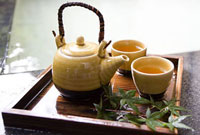 Chinese tea culture refers to the methods of preparation of tea, the equipment used to make tea and the occasions in which tea is consumed in China. The terms chayi "Art of Tea (simplified Chinese:茶艺; traditional Chinese: 茶藝, pinyin: chá yì)" and "Tea Ceremony" have been used, but the term "Tea Culture茶文化" includes more than just the ceremony. Also "culture" is easier to translate into English from the Chinese term "art (simplified Chinese:艺; traditional Chinese: 藝, pinyin: yì".
Chinese tea culture refers to the methods of preparation of tea, the equipment used to make tea and the occasions in which tea is consumed in China. The terms chayi "Art of Tea (simplified Chinese:茶艺; traditional Chinese: 茶藝, pinyin: chá yì)" and "Tea Ceremony" have been used, but the term "Tea Culture茶文化" includes more than just the ceremony. Also "culture" is easier to translate into English from the Chinese term "art (simplified Chinese:艺; traditional Chinese: 藝, pinyin: yì".
Tea culture in China differs from that of Europe, Britain or Japan in such things as preparation methods, tasting methods and the occasions for which it is consumed. Even now, in both casual and formal Chinese occasions, tea is consumed regularly. In addition to being a drink, Chinese tea is used in traditional Chinese medicine and in Chinese cuisine.
Etymology
For contemporary Chinese, the word "茶" (pinyin: chá) has come to commonly denote the drink that is derived from Camellia sinensis, the tea plant (simplified Chinese:茶樹; traditional Chinese: 茶树, pinyin: cháshù). Prior to the 8th century BC, the tea was known collectively under the term "荼" (pinyin: tú) along with a great number of other bitter plants. The great similarity of the two characters are notable with the exception of an additional horizontal stroke in 荼. The character is made up of the "艸" (pinyin: cǎo) radical in its reduced form of "艹" and the word "余" which gives the phonetic cue. The plant was later more distinctly identified and was called "檟苦荼" (pinyin: jiǎkǔtú, literally "'evergreen shrub' of bitter 'bitter plant'"), or in simplified forms "苦荼" (pinyin: kǔtú) or "荈" (pinyin: chuǎn).
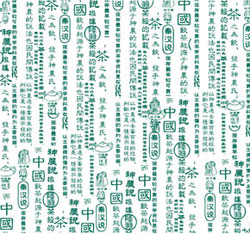 The word "茗" (pinyin: míng), which was possibly derived from the Burmese word, was later used to indicate tea where its popularity spread and became more common in Ancient China. This word is still used in modern tea communities in Taiwan and the People's Republic of China to denote tea. By the end of the 8th century BC, the character "荼" was finally simplified to "茶". Lù Yǔ (陸羽/陆羽, 733-804) of the Tang Dynasty, wrote in his crowning work, The Tea Classic or Chájīng (茶經/茶经), on the origins of the character for tea as well as the numerous words used to denote tea. In the first chapter of Chájīng, "The origins" (卷上, 一之源) he wrote:
The word "茗" (pinyin: míng), which was possibly derived from the Burmese word, was later used to indicate tea where its popularity spread and became more common in Ancient China. This word is still used in modern tea communities in Taiwan and the People's Republic of China to denote tea. By the end of the 8th century BC, the character "荼" was finally simplified to "茶". Lù Yǔ (陸羽/陆羽, 733-804) of the Tang Dynasty, wrote in his crowning work, The Tea Classic or Chájīng (茶經/茶经), on the origins of the character for tea as well as the numerous words used to denote tea. In the first chapter of Chájīng, "The origins" (卷上, 一之源) he wrote:
其字:或從草,或從木,或草木並。 qí zì : huò cóng cǎo, huò cóng mù, huò cǎo mù bìng.
which means: "Its character: may come from herb/grass (茶 chá from 文字音義 Wénzì yīnyì in 736 AD), or from tree/wood (梌 tú from 本草經 Běncǎojīng, an ancient medical text), or the combination of the two (荼 tú from the 爾雅 Ěryǎ, atreatise on lexicography from the Han dynasty)"
其名:一曰茶,二曰檟,三曰蔎,四曰茗,五曰荈。 qí míng: yī yuē chá, èr yuē jiǎ, sān yuē shè, sì yuē míng, wǔ yuē chuǎn.
which means: Its names: first it is called 茶 chá, then 檟 jiǎ, thirdly 蔎 shè, fourthly 茗 míng, fifthly 荈 chuǎn.
Where:
檟 jiǎ: according to the author Yang Xiong of Han dynasty, the term was used by Zhōugōng (周公), the duke of Zhou dynasty to indicate the 苦荼 (kǔtú)
蔎 shè: the term by which natives of present day Sìchuān used to indicated 荼 (tú)
茶,蔎,茗,荈 chá, shè, míng, chuǎn: in legends, Guōhóngnóng (郭弘農), specified that first tea harvest is known as chá, followed by míng, then shè, and finally chuǎn
Tea drinking customs
There are several special circumstances in which tea is prepared and consumed.
As a sign of respect
In Chinese society, the younger generation always shows their respect to the older generation by offering a cup of tea. Inviting their elders to go to restaurants and having some tea is a traditional activity on holidays. In the past, people of lower rank served tea to higher ranking people. Today, as Chinese society becomes more liberal, sometimes parents may pour a cup of tea for their children, or a boss may even pour tea for subordinates at restaurants. However, the lower ranking person should not expect the higher ranking person to serve him or her tea in formal occasions.
For a family gathering
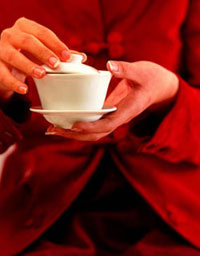 When sons and daughters leave home because of work or get married, they may have few times to visit their parents, and parents may seldom meet their grandchildren as well. Therefore, going to restaurants and drinking tea becomes an important activity for family gatherings. Every Sunday, Chinese restaurants are crowded, especially when people celebrate festivals. This phenomenon reflects Chinese family values.
When sons and daughters leave home because of work or get married, they may have few times to visit their parents, and parents may seldom meet their grandchildren as well. Therefore, going to restaurants and drinking tea becomes an important activity for family gatherings. Every Sunday, Chinese restaurants are crowded, especially when people celebrate festivals. This phenomenon reflects Chinese family values.
To apologize
In Chinese culture, people make serious apologies to others by pouring tea for them. For example, children serving tea to their parents is a sign of regret and submission.
To express thanks to your elders on one's wedding day
In the traditional Chinese marriage ceremony, both the bride and groom kneel in front of their parents and serve them tea. That is the most devout way to express their gratitude. In front of their parents, it is a practice for the married couple to say, "Thank you for bringing us up. Now we are getting married. We owe it all to you." The parents will usually drink a small portion of the tea and then give them a red envelope, which symbolizes good luck. Another variant is that the bride serve tea to the groom's parents, symbolizing that she is to become a part of the latter's family.
To connect large families on wedding days
The tea ceremony during a wedding also serves as a means for both parties to meet with each other. As Chinese families can be rather extended, and there may be one or two hundred people, it is entirely possible during a courtship to not have been introduced to someone. This was particularly true in older generations where the patriarch may have had more than one wife and not all family members were always on good terms. As such, during the tea ceremony, the couple would serve tea to all family members and call them by their official title. Drinking the tea symbolized acceptance into the family, while refusing to drink symbolized opposition to the wedding and was quite unheard of since it would result in a loss of "face". Older generations would give a red envelope to the matrimonial couple while the couple would be expected to give red envelopes to the unmarried younger ones.
Folding the napkin in tea ceremonies is a traditional action and is done to keep away bad Qi energy in China as tea (茶) was regarded as one of the seven daily necessities. The others being firewood, rice, oil, salt, soy sauce, and vinegar (simplified Chinese: 柴, 米, 油, 盐, 酱, 醋; traditional Chinese: 柴, 米, 油, 鹽, 醬, 醋; pinyin: chái , mǐ , yóu , yán , jiàng , cù ).
Finger tapping
Light finger tapping is a custom for thanking the tea master or tea server for tea. After a person's cup is filled, that person may knock their bent index and middle fingers (or some similar variety of finger tapping) on the table to express gratitude to the person who served the tea. Although this custom is common in southern Chinese culture such as the Cantonese, in other parts of China it is only acceptable if for some reason you cannot actually say thank you at that moment, for example if you are in the middle of talking with someone else at the table.
This custom is said to have originated in the Qing Dynasty when Emperor Qian Long would travel in disguise through the empire. Servants were told not to reveal their master's identity. One day in a restaurant, the emperor, after pouring himself a cup of tea, filled a servant's cup as well. To that servant it was a huge honour to have the emperor pour him a cup of tea. Out of reflex he wanted to kneel and express his thanks. He could not kneel and kowtow to the emperor since that would reveal the emperor's identity so he bent his fingers on the table to express his gratitude and respect to the emperor.
The bent fingers for knocking are technically supposed to be three to signify a bowing servant. One is the head and the other two are the arms.
It should be noted that in formal tea ceremonies nodding of the head and/or saying "thank you" is more appropriate.
Tea ceremonies
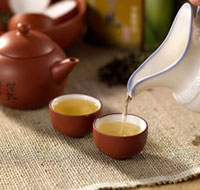 The Chinese tea ceremony, also called the Chinese Way of Tea, is a Chinese cultural activity involving the ceremonial preparation and presentation of tea leaf. The manner in which it is performed, or the art of its performance is shown in the tea ceremony. Taoism has also been an influence in the development of the tea ceremony. The elements of the Chinese tea ceremony is the harmony of nature and enjoying tea in an informal and formal setting. Tea ceremonies are now being revived in China's new fast-paced culture, and continuing in the long tradition of intangible Chinese art.
The Chinese tea ceremony, also called the Chinese Way of Tea, is a Chinese cultural activity involving the ceremonial preparation and presentation of tea leaf. The manner in which it is performed, or the art of its performance is shown in the tea ceremony. Taoism has also been an influence in the development of the tea ceremony. The elements of the Chinese tea ceremony is the harmony of nature and enjoying tea in an informal and formal setting. Tea ceremonies are now being revived in China's new fast-paced culture, and continuing in the long tradition of intangible Chinese art.
Influence of tea on Chinese culture
Tea has had a major influence on the development of Chinese culture. Chinese traditional culture is closely connected with Chinese tea. In literature, arts, and philosophy, tea is often associated. Tea is connected closely with Taoism, Buddhism and Confucianism. Roughly, since Tang Dynasty, drinking tea is a must for self-cultivation. Chinese Chan (or Japanese Zen) philosophy is also linked with drinking tea.
Tea ware
Traditionally tea drinkers were regarded as the academic and cultural elites of society because the practice of drinking tea was considered to be an expression of personal morality, education,
social principles, and status. Increased enthusiasm for tea drinking led to the greater production of tea ware, and also significantly popularized Chinese porcelain culture.
Teahouse
Chinese scholars have used the teahouse for places of sharing ideas.
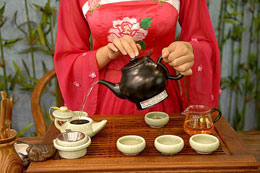 Teahouse is the by-product of Chinese t
Teahouse is the by-product of Chinese t
ea culture but it also the historical evidence of Chinese tea history. Currently, people can also feel such a kind of humanistic atmosphere in Beijing like Lao She Teahouse and East China like Hangzhou, Suzhou, Yangzhou, Nanjing, Wuxi, Shaoxing and Shanghai and so on. It is still dynamic and vigorous.
Modern culture
In modern China, virtually every dwelling — even down to the simplest mud hut — has a set of tea implements for brewing a hot cup of tea. These implements are symbols of welcome for visitors or neighbors. Traditionally, a visitor to a Chinese home will be expected to sit down and drink tea while talking; the Chinese consider having such visits while standing to be uncouth. There are several types of tea: green tea, oolong tea, red tea, black tea, white tea, yellow tea, puerh tea and flower tea. Tea leaves are traditionally produced by constantly turning fresh leaves in a deep bowl. This process allows the tea to dry with its full flavor ready to be used.